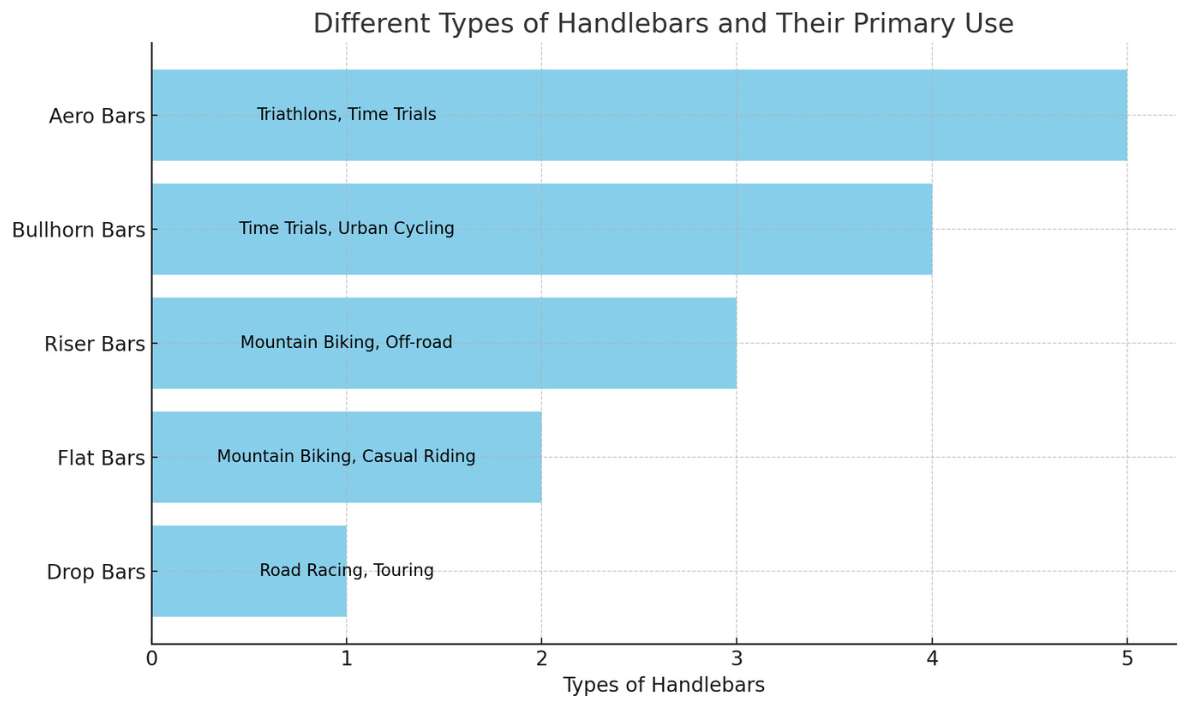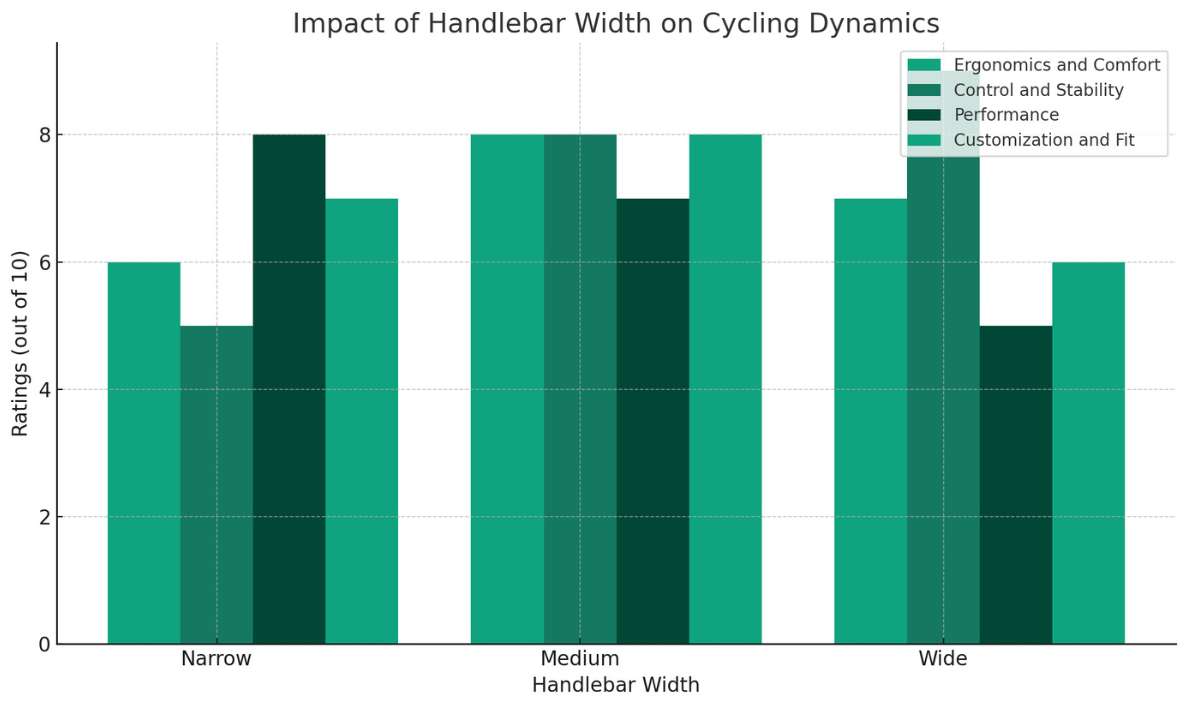
The Importance of Correct Handlebar Width in Cycling
Key Takeaways
| Aspect | Details |
|---|---|
| Comfort | Correct handlebar width ensures rider comfort, minimizing strain on the arms and shoulders. |
| Control | Proper width improves bike control, particularly in challenging terrains and turns. |
| Performance | Optimal handlebar width can enhance aerodynamics and efficiency, contributing to better cycling performance. |
| Customization | Tailoring handlebar width to individual needs can be done at home or with professional help, enhancing the riding experience. |
Understanding Handlebar Width: A Crucial Component for Cyclists
When it comes to cycling, every detail of your bike setup can impact your comfort, control, and overall performance. One aspect often overlooked yet critically important is the handlebar width. This isn't just a trivial matter of bike aesthetics; it's a key factor in ensuring a comfortable and efficient ride. Whether you're a road warrior, a mountain bike enthusiast, or a casual rider, understanding and adjusting your handlebar width is vital.
Why Handlebar Width Matters
-
Ergonomics and Comfort: The right handlebar width is crucial for maintaining a comfortable riding posture. Handlebars too wide or too narrow can lead to discomfort and strain in your arms, shoulders, and back. The ideal width should allow for a natural arm position, with your hands aligning with your shoulders for a relaxed ride.
-
Control and Stability: Handlebar width significantly influences how you control your bike. Wider bars offer more leverage and stability, especially useful in mountain biking where navigating rough terrains is common. Conversely, narrow handlebars offer more aerodynamic advantages but may reduce stability.
-
Performance: The width of your handlebars can impact your bike's aerodynamics. Narrow handlebars reduce wind resistance, which can be beneficial for racing and speed-focused riding. On the other hand, wider bars provide better control and leverage, ideal for off-road and mountain biking.
Finding Your Perfect Handlebar Width

-
Measure Your Shoulders: A standard method to find your ideal handlebar width is by measuring the distance between your acromioclavicular (AC) joints, the bony bits at the top of your shoulders. This measurement often serves as a baseline to start from.
-
Consider Your Riding Style: Your handlebar width should complement your riding style. If you're into road cycling, a width between 38 cm to 46 cm is generally suitable. For mountain biking, a wider range of 74 cm to 76 cm is recommended for better control and shock absorption.
-
Personal Preference: Comfort is subjective. Some riders prefer handlebars slightly wider than their shoulder width for a more open chest position, while others might opt for narrower bars for speed and aerodynamics.
-
Adjusting Handlebars: Changing your handlebar width can be a DIY project or done professionally. It involves selecting the right size handlebars and adjusting them to your comfort. For detailed guidance, check out our comprehensive handlebar positioning guide.
Road Bikes vs. Mountain Bikes: A Comparison
-
Road Bike Handlebars: Typically narrower to promote aerodynamics and speed. The average width ranges from 38 cm to 46 cm. Ideal for riders focusing on speed and long-distance efficiency.
-
Mountain Bike Handlebars: Generally wider, providing better control and stability on rough terrains. The average width is between 74 cm and 76 cm, with downhill bikes having even wider bars for enhanced control.
Wide vs. Narrow Handlebars: Pros and Cons
-
Wide Handlebars:
- Pros: Better control and stability, particularly on uneven terrains. They also offer a stronger riding position and are better suited for narrow trails and off-road conditions.
- Cons: Can be less aerodynamic and require more power to steer, especially during sharp turns.
-
Narrow Handlebars:
- Pros: Increased aerodynamics and speed. They are also lighter and can be more comfortable for riders who prefer a compact riding position.
- Cons: Might offer less control and stability, particularly in off-road conditions.
Adjusting to Your Needs
Remember, the right handlebar width is not a one-size-fits-all solution. It varies based on individual physiology, riding style, and personal preference. Making adjustments to find your ideal width is not only about enhancing your cycling experience but also about preventing discomfort and potential injuries. For insights into other important bike fit aspects, explore our articles on bike frame geometry basics and the importance of bike size.
Enhancing Your Ride: The Role of Bike Fit in Handlebar Selection
Selecting the right handlebars goes beyond just width. It's part of a larger puzzle that is your bike's fit. An optimal bike fit ensures that every element, from the handlebars to the saddle, works in harmony to provide the best riding experience.
Integrating Handlebar Width with Overall Bike Fit
-
Saddle Position: The relationship between your handlebars and saddle is crucial. Handlebar width and reach should allow for a comfortable position without straining to reach the bars. Adjusting your saddle height and angle can also impact how your handlebar width feels. Learn more about adjusting saddle height and saddle angle setting.
-
Stem Length: Stem length affects your reach to the handlebars. A longer stem with narrower handlebars can stretch your position too much, while a shorter stem with wider bars can make your ride feel cramped. For more on finding the right balance, read our article on stem length bike fit.
-
Foot Position: Your pedaling efficiency is also tied to handlebar width. A wider handlebar can change your upper body position, potentially affecting how you pedal. Understanding the connection between these elements is key, as detailed in our guide on foot position bike fit.
The Impact of Riding Style on Handlebar Choice

Your cycling discipline significantly influences your handlebar width and style. Road cyclists often prioritize aerodynamics and speed, opting for narrower bars. In contrast, mountain bikers and off-road enthusiasts prefer wider bars for control and stability. Read more about how riding style affects bike fit in our article on bike fit and riding styles.
Flexibility and Comfort in Cycling
Rider flexibility and comfort preferences play a significant role in handlebar selection. Flexible riders might be more comfortable with a lower handlebar position, while those seeking comfort might prefer a more upright position. For insights into how flexibility impacts bike fit, explore our piece on rider flexibility and bike fit.
Balancing Comfort and Performance
The ultimate goal in choosing the right handlebar width, like any aspect of bike fitting, is to strike a balance between comfort and performance. While a professional cyclist might sacrifice some comfort for performance gains, recreational riders typically prioritize comfort. Understanding this balance is crucial, as discussed in our article on bike fit: comfort vs. performance.
In conclusion, the importance of correct handlebar width cannot be overstated in the realm of cycling. It's a critical component that affects your comfort, control, and overall cycling performance. By considering factors like shoulder width, riding style, and integrating it with overall bike fit, you can enhance your cycling experience significantly. Remember, the perfect handlebar width is one that suits your body and your riding needs, ensuring that every ride is both enjoyable and efficient.
Tailoring Your Cycling Experience: Advanced Considerations for Handlebar Width
To further refine your cycling experience, it's important to delve deeper into the nuances of handlebar width. This includes understanding advanced ergonomic principles, the impact of different materials, and the role of technology in achieving the perfect fit.
Ergonomic Principles in Handlebar Design
-
Wrist Alignment: Proper handlebar width should align with your natural wrist position. Misalignment can lead to discomfort or even injury over long rides. An ergonomically designed handlebar considers this, promoting a neutral wrist position.
-
Upper Body Posture: The width of your handlebars influences your upper body posture. A width that aligns well with your shoulder width ensures a more natural, upright posture, reducing the risk of back and neck strain.
-
Grip and Hand Fatigue: Handlebars that are too wide or too narrow can lead to improper grip, increasing the risk of hand fatigue and discomfort. Ergonomic handlebar designs often include features like varied grip diameters and shapes to accommodate different hand sizes and preferences.
Material Matters: Choosing the Right Handlebars
The material of your handlebars can affect their performance and your comfort. Lightweight materials like carbon fiber offer vibration damping properties, which can be beneficial for reducing fatigue. Aluminum handlebars, on the other hand, are more affordable and provide a stiffer ride, which some cyclists prefer for the feel of responsiveness.
Leveraging Technology for Perfect Handlebar Fit
Modern technology, like the advanced AI-driven solutions offered by BikeFittr, can play a significant role in determining the ideal handlebar width. By analyzing your riding posture and preferences, AI-powered tools provide personalized recommendations, making the fitting process more accurate and user-friendly. Learn more about these innovations in our comprehensive guide on basic bike fit principles.
The Role of Customization and Personal Preference
Ultimately, the choice of handlebar width is highly personal. Factors like hand size, arm length, and personal comfort preferences should guide your decision. Customizing your handlebars to match these personal attributes can significantly enhance your riding experience.
Conclusion: The Art and Science of Handlebar Width
Selecting the correct handlebar width is both an art and a science. It requires a balance of ergonomic principles, material considerations, and personal preferences. By understanding these elements and utilizing available technology, cyclists can achieve a handlebar fit that enhances comfort, control, and performance, making every ride a tailored experience.
With this comprehensive understanding of handlebar width, cyclists are well-equipped to make informed decisions that will elevate their cycling experience. Whether you're adjusting your current setup or choosing new handlebars, the insights provided here will ensure you make the best choice for your unique riding needs.